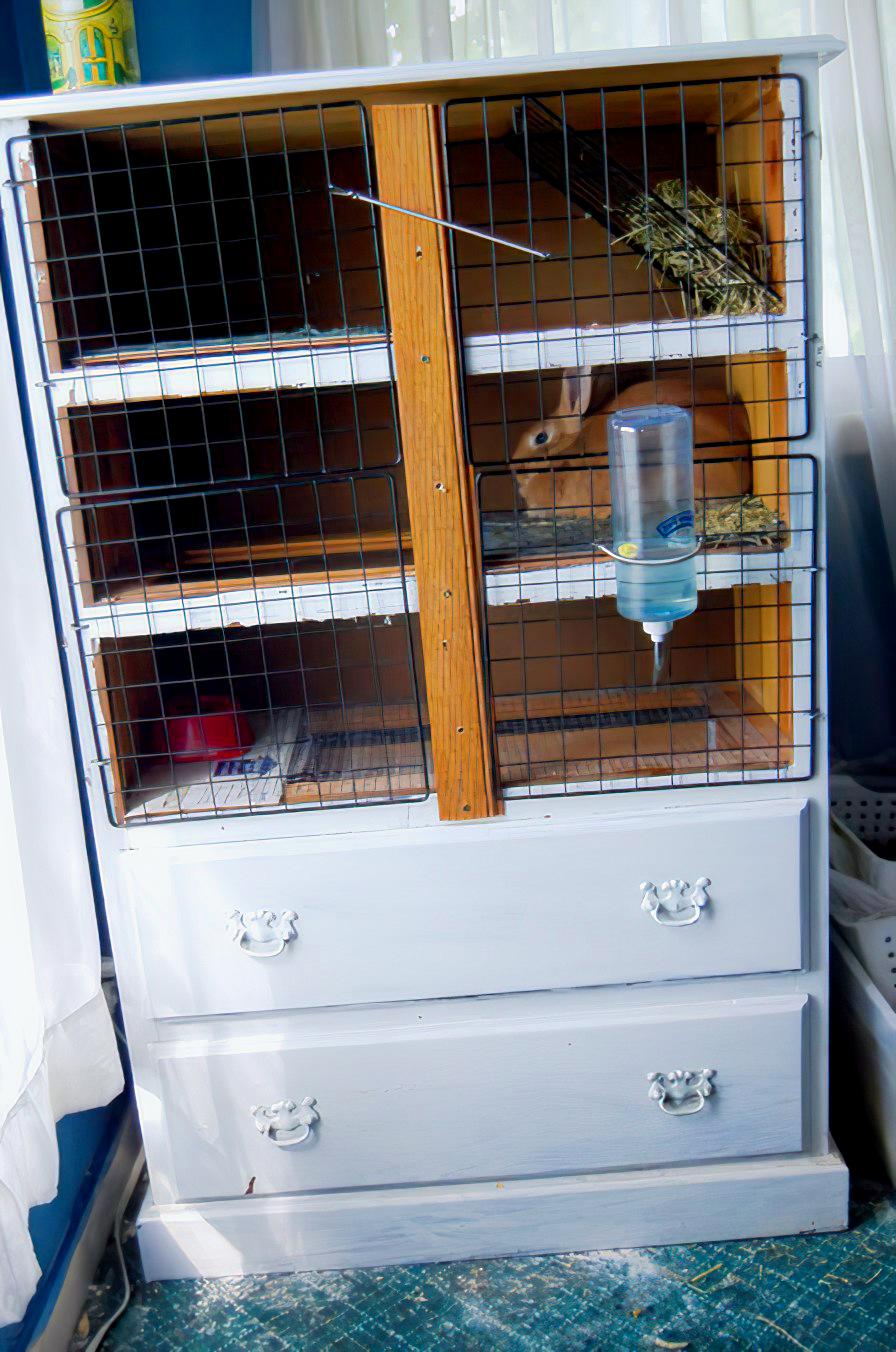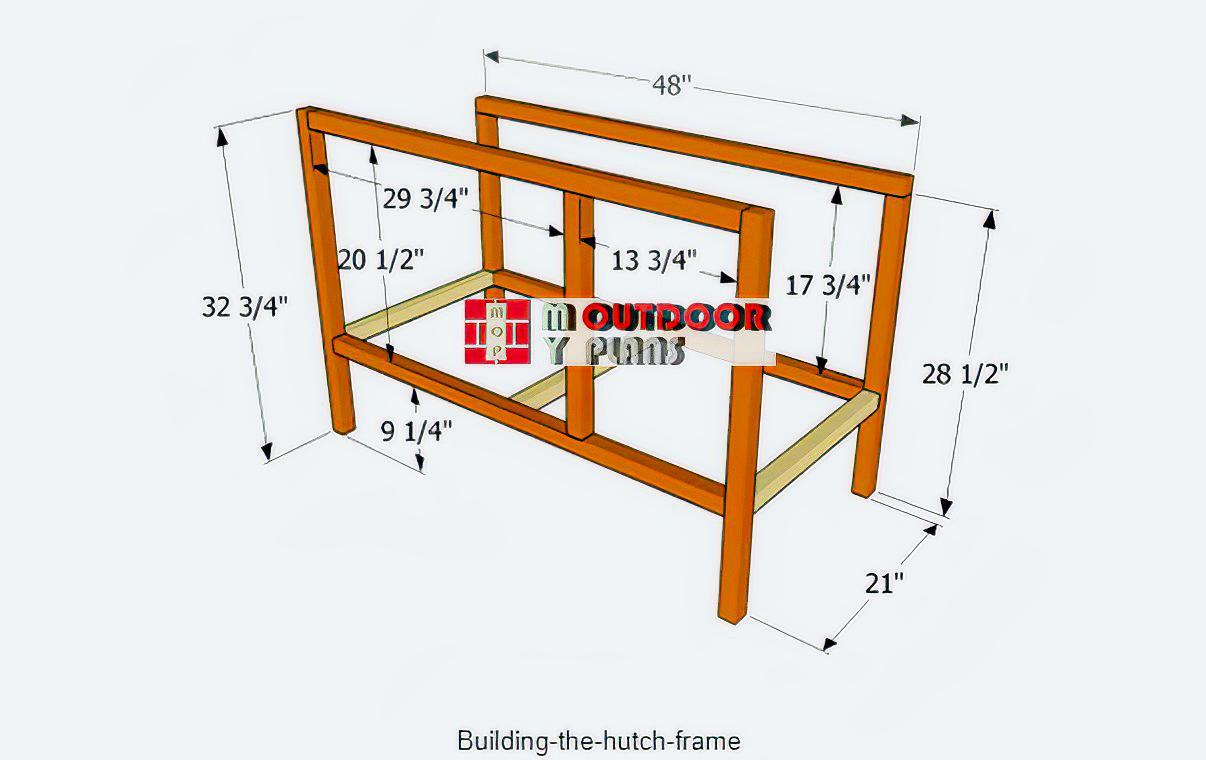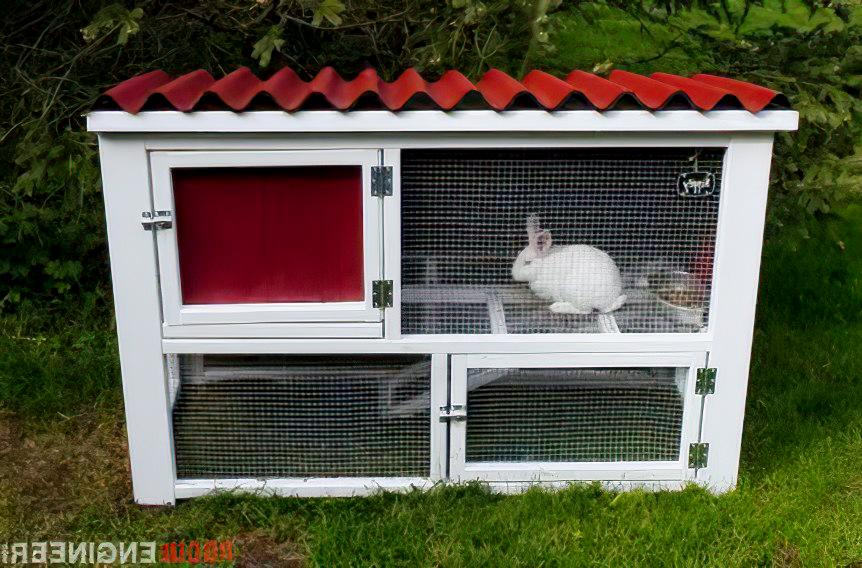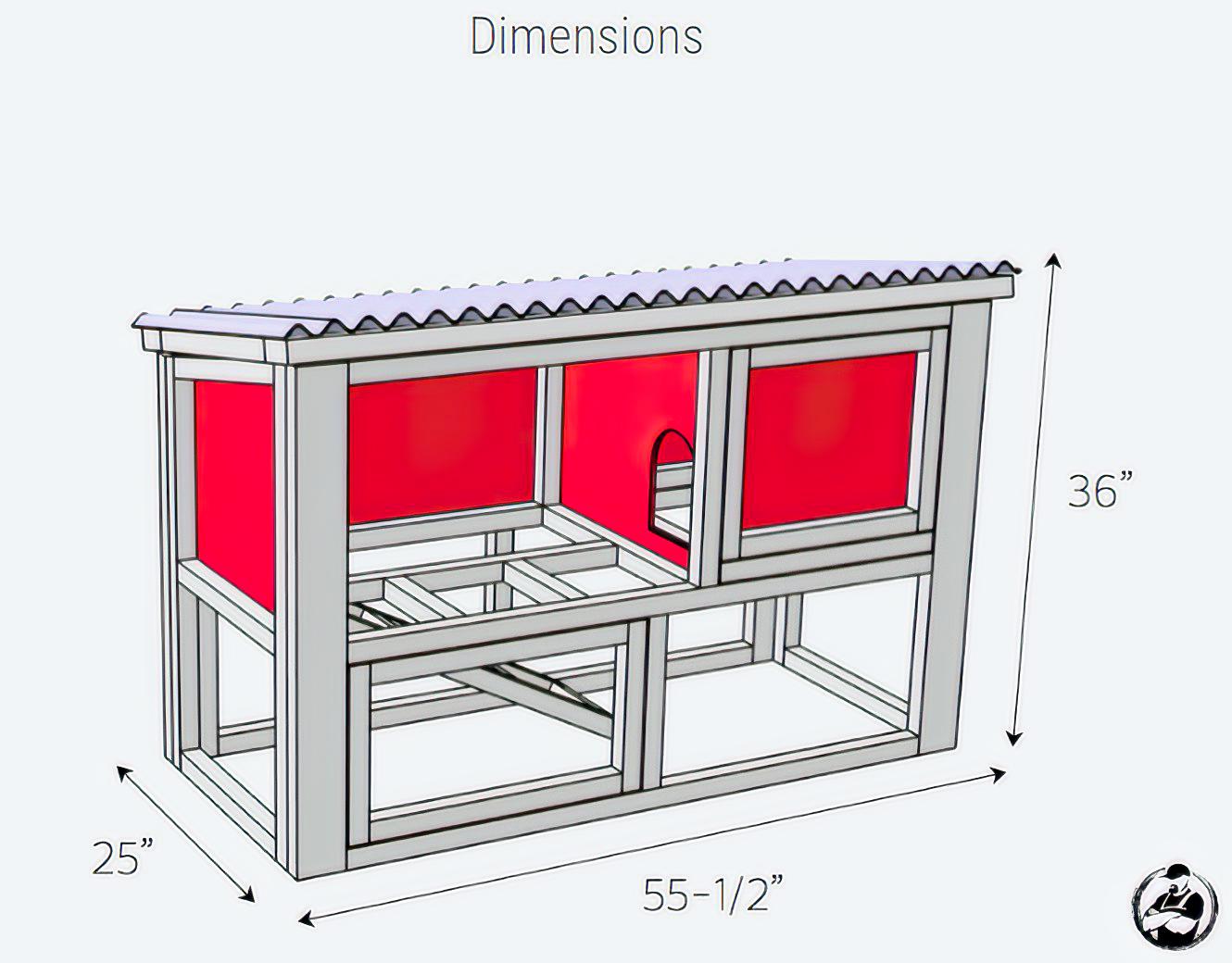A rabbit hutch or bunny hutch is a large rabbit enclosure suitable for housing rabbits outdoors or in a barn. You can also build smaller indoor rabbit enclosures or hutches (even using old furniture).
Think of a rabbit hutch as like a rabbit cage but much larger. It’s designed to be a safe space for your rabbits to lounge, roam and sleep.
A well-built rabbit hutch should offer a suitable place for your rabbits to shelter from predators and ideally it should be constructed out of robust wooden materials and netting which won’t deteriorate in extremes of weather. You can build your rabbit hutch so that it has a frame elevating it off the ground with legs or build a hutch with wheels if you want to be able to move it around.
Your rabbit hutch should also have space for a terracotta food bowl, a water bowl or water dispensers as well as healthy amounts of straw (timothy or oxbow hay). Your rabbits will typically choose a corner of your rabbit hutch to toilet in apart from their eating area. So you will need to be able to routinely access your rabbit hutch to clean it regularly to make a hygienic and comfortable living space for your rabbits.
This article explains how to construct a very simple rabbit hutch and the types of building materials and tools you will need. You can also customize your rabbit hutch to meet the needs of your rabbit family as well as the size of your yard (or home) to accommodate it.
What are the key construction materials required to build a rabbit hutch?
The type and amount of materials you will require depends upon how large you intend to build your rabbit hutch. You can build one, two or even multiple storey rabbit hutches. Some rabbit owners even customize old pieces of furniture (like a dresser) to turn it into suitable rabbit housing.
Using an old dresser (like the image below) also gives you a place to store their rabbit food in the dresser drawers. Although the image shown below would make a nice rabbit hutch for an indoor rabbit – it would realistically only comfortably house one medium sized rabbit or at best a pair of dwarf bunnies.

There are many different types of rabbit hutch plans you can find online to help you design and construct your rabbit hutch. The basic materials you will need will include enough good quality timber to construct your rabbit hutch frame, dividing wooden panels, floors and ceilings.
You will need to purchase durable (and tough) and good quality rabbit meshing to allow you to look into the hutch and for your bunnies to be able to look out. The meshing should be strong enough to prevent predators like foxes breaking into it. You will also need wood glue, screws and other materials to join the pieces together.
If you decide to build a simple outdoor rabbit hutch which looks like the drawing below, you will require a range of basic building materials (listed below).
The building materials required to build the rabbit hutch similar to the one shown above will include:
- 6 pieces of 2×2 lumber – measuring 8 inches.
- 9 pieces of 1×4 lumber – measuring 8 inches.
- 1 piece of ½ plywood measuring 4 inches x 8 inches.
- 1 piece of ¼ plywood measuring 2 inches by 2 inches.
- 100 pieces of 2 ½ screws.
- 100 pieces of 1 ¼ screws.
- 2 hinges.
- 15 square feet of tar paper.
- 15 square feet of shingles (for the roofing).
Breaking down this list further, the frame will require (from the material above):
- 2 pieces of 2×2 lumber (roughly 33 inches long).
- 2 pieces of 28½ inch lumber.
Your flooring will require one piece of ½ plywood measuring 24 inches by 48 inches in length. For the interior wall you should use one piece of ¼ plywood measuring 21 x 22 ½ inches long and two pieces of 2×2 lumber).
For the slats you will need around 12 pieces of 1×4 lumber – 24¾ inches in length – and six pieces of 48 inch slats. For the door you will need 2 pieces of 2×2 lumber about 17¼ inches long and 2 pieces of lumber measuring 29 ¾ inches long. Your roofing will need one piece of ½ plywood measuring 27¾ x 52½ inches in length and long asphalt shingles to complete your roofing materials. You can find the full floor plan for that particular design at this website .
My Outdoor Plans who designed the rabbit hutch suggested for this article recommend that you start your build with the frame appearing as follows:

Tools you will need
You will need the following basic tools to build the rabbit hutch which you can adjust to meet the complexity of your build:
- Hammer, tape measure, (pencil), framing square and spirit level.
- Cutting equipment – Miter saw, circular saw, jig saw and/or table saw.
- Drill machinery and screwdrivers.
- Sanding paper.
- Post hole digger – and small concrete mixer.
- Safety gloves, safety glasses and ear protection.
- Screws (assorted).
- Wood glue.
There are numerous websites with free plans and designs for you to download or customize to help you build a simple rabbit hutch. If you follow the instructions carefully, a simple rabbit hutch design like the one shown above should only take you a day to complete building.
What are the main health considerations when building a rabbit hutch?
A well-designed rabbit hutch should be a safe place for your pet or show rabbits to exercise, free-roam, sleep and feel safe. It should be hygienic and clean and with solid wooden floors or a similar material which can be hosed out to remove rabbit droppings and urine stains. Wooden floors are preferable to wire mesh as this can cause your rabbits to develop sore hocks from perching on the wire all day.
You want to ensure that your rabbit hutch never has a build up of damp hay (urine-soaked) creating an unpleasant ammonia odor which isn’t good for your rabbits’ health. To solve this problem consider adding a cat litter tray in the corner of your rabbit hutch and training your rabbits to use it. Rabbits (like cats) can be litter trained relatively easily. Most rabbits will choose to urinate or defecate in the same section of their hutch anyway. This makes cleaning a lot easier.
Your rabbit hutch must be secure enough so that your rabbits can’t easily escape or that predators (such as foxes or coyotes) can’t access it. If you are planning on breeding, it’s good practice to include a nest box for any future litters as well as a space for your doe to safely give birth when her time comes. Your rabbit hutch can also house other small rabbits like guinea pigs, if they can mingle well with your rabbit population.
You should always choose not only good quality building materials but those which are non-toxic for rabbits. Untreated wood (such as pine) is fine and plywood is also commonly used as hutch building materials (particularly dividing panels).
Avoid using medium density fibreboard (MDF) which can be toxic if your rabbits chew it or they breathe in the dust. MDF also breaks down into mush when it gets wet. It doesn’t perform well in extreme temperatures and won’t support much weight. Avoid using any MDF components in your rabbit hutch build.
A well constructed rabbit hutch will deliver sufficient protection from extremes of weather – heat and cold – and not be too drafty while providing a comfortable place for your rabbits to feel safe and protected.
How big does my rabbit hutch need to be?
Like most things in life, size does matter. If you have a pair of rabbits of a medium-sized breed (8 pounds and over) you must have a hutch size of at least 10 square feet. If your rabbits become aggressive towards the others in the hutch this is a sign that your hutch is too small to accommodate them. Rabbits are territorial (like most mammals) and need adequate space to roam, rest and eat.
It’s important that your rabbit hutch is tall enough so that your rabbits can stand up on their hind legs and they should be able to make at least 3 bunny hops from one side to another. This is where building a two storey rabbit hutch can be beneficial as it gives them more room to move and explore.
You might also want to craft a predator-safe rabbit run on the outside of your hutch or your barn so that your rabbits can move around a bit more safely. Many animal rescue organizations in the United States will include a predator safe run attached to rabbit hutches which are at least 10 feet by 6 feet with a run height of at least three feet. More space is always better.
Nevertheless, your rabbits shouldn’t be confined to their rabbit hutch all day. If you can, you should allow them to roam around your house or small backyard (as long as they are safe from predators) for some additional exercise.
If you don’t feel confident about building your own rabbit hutch, you can purchase constructed ones or even buy them in easy to build kits. But buying a rabbit hutch will be a bit more expensive than if you source the materials and plans yourself and build from scratch.
If you want to build a multi-storey rabbit hutch you might want to consider the following design:

The internal dimensions and interior of that rabbit hutch looks like this:

The design for the above rabbit hutch is also relatively simple for a beginner to construct and this hutch features an upper and lower deck where your rabbit can huddle in cooler weather.
Regardless of which design you choose, the fundamentals of intelligent design remain the same. Your rabbit hutch must be comfortable with enough space for your rabbits to live where they are safe from predators. It must be easy to clean and maintain with a free flow of fresh air (but not too drafty).
Waterproofing your rabbit hutch
You can also waterproof the wood of your rabbit hutch and you might want to install windbreaks around both your hutch and your external rabbit run. To do this, you first line your hutch with a double wall and an extra layer of insulation. Use clear sheeting, plastic, plexiglass or even perspex sheet to the front part of the hutch. Clear sheeting allows your rabbits to be able to look out of the hutch and not feel too claustrophobic.
Rabbits love to dig so you might want to add a spot in your rabbit hutch which will allow them to do this. You could place a flower pot in the center with some dirt or even add a largish wicker basket with lots of shredded newspaper for them to play in and dig.
Regardless of how you choose to configure your rabbit hutch, your rabbits will reward you with lots of affection if you provide them with a safe and fun place to spend their downtime. Remember that rabbits still need some time to roam and explore outdoors (and away from their rabbit hutch). Use this time as your opportunity to clean and sanitize their living quarters and refresh the hay, fresh water and food.



Leave a Reply